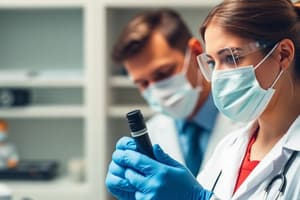Podcast
Questions and Answers
What significant event related to forensic science occurred in 44 BC?
What significant event related to forensic science occurred in 44 BC?
The first recorded autopsy
In the 400s, what was required of medical experts?
In the 400s, what was required of medical experts?
Medical experts must determine the cause of death
What identification method was first used in the 600s?
What identification method was first used in the 600s?
Fingerprints
What is significant about the year 1248 in forensic science?
What is significant about the year 1248 in forensic science?
What development in forensic science occurred in the 1600s?
What development in forensic science occurred in the 1600s?
What notable instance happened in 1784 concerning physical evidence?
What notable instance happened in 1784 concerning physical evidence?
What chemical determination occurred in 1836?
What chemical determination occurred in 1836?
Which city started using photography for criminal identification in 1854?
Which city started using photography for criminal identification in 1854?
What was discovered about fingerprints in 1880?
What was discovered about fingerprints in 1880?
What important literary work related to forensic science was published in 1887?
What important literary work related to forensic science was published in 1887?
What crime analysis method was developed in 1888?
What crime analysis method was developed in 1888?
In what year were fingerprints first used as evidence?
In what year were fingerprints first used as evidence?
What was developed in 1901 regarding human blood?
What was developed in 1901 regarding human blood?
Where was the first school of forensic science founded in 1909?
Where was the first school of forensic science founded in 1909?
What forensic application was noted in hair analysis in 1910?
What forensic application was noted in hair analysis in 1910?
What characteristic of guns was recognized in 1912?
What characteristic of guns was recognized in 1912?
What significant establishment occurred in Los Angeles in 1923?
What significant establishment occurred in Los Angeles in 1923?
What technology was utilized in 1930 for forensic investigation?
What technology was utilized in 1930 for forensic investigation?
What major development occurred in the FBI in 1932?
What major development occurred in the FBI in 1932?
What evidentiary method was introduced in 1960?
What evidentiary method was introduced in 1960?
What system was established in 1967 related to national crime?
What system was established in 1967 related to national crime?
What advancement occurred in gun residue analysis in 1974?
What advancement occurred in gun residue analysis in 1974?
Which country pioneered the first auto fingerprint system in 1979?
Which country pioneered the first auto fingerprint system in 1979?
What technology did Sir Alec Jeffreys develop in 1984?
What technology did Sir Alec Jeffreys develop in 1984?
What significant event related to criminal apprehension occurred in 1987?
What significant event related to criminal apprehension occurred in 1987?
What conclusion regarding DNA evidence was reached in 1996?
What conclusion regarding DNA evidence was reached in 1996?
What does AFIS stand for, introduced in 1999?
What does AFIS stand for, introduced in 1999?
What advancement in DNA profiling occurred in 2001?
What advancement in DNA profiling occurred in 2001?
What system was introduced in 2007 to aid forensic investigations?
What system was introduced in 2007 to aid forensic investigations?
What forensic technique became notable in 2011 regarding facial recognition?
What forensic technique became notable in 2011 regarding facial recognition?
Flashcards are hidden until you start studying
Study Notes
Key Developments in Forensic Science Timeline
-
44 BC: First recorded autopsy marks the beginning of forensic examination to determine cause of death.
-
400s: Medical experts tasked with determining causes of death, enhancing the practice of forensic investigation.
-
600s: Introduction of fingerprints as a method for identity verification, laying the groundwork for modern forensic identification.
-
1248: Publication of the first forensic science manual, establishing formal guidelines and principles for the field.
-
1600s: The era sees the publication of the first pathology reports, contributing to the understanding of disease and injury in forensic contexts.
-
1784: Landmark case where physical evidence leads to a murder conviction, showcasing the importance of evidence in the judicial process.
-
1836: Utilization of chemical processes to ascertain arsenic poisoning, highlighting advancements in toxicology within forensics.
-
1854: San Francisco implements photography for criminal identification, revolutionizing how evidence and suspects are documented.
-
1880: Discovery that fingerprints are unique, solidifying their role as reliable evidence in criminal investigations.
-
1887: Coroners given authority to determine the cause of death; also marks the publication of the first Sherlock Holmes story, influencing public interest in forensics.
-
1888: Introduction of numerical measurements to evaluate criminal features, advancing the methods of criminal profiling.
-
1892: Fingerprints utilized as evidence for the first time in a case, underscoring their significance in legal proceedings.
-
1901: Development of the ABO blood grouping system, facilitating blood analysis in forensic investigations.
-
1909: Establishment of the first school of forensic science in Switzerland, formalizing education and training in the field.
-
1910: Introduction of hair analysis in forensic investigations, further diversifying evidence types.
-
1912: Recognition that guns possess unique characteristics, allowing for ballistic identification in investigations.
-
1923: Construction of the first crime lab in Los Angeles, marking a significant development in crime scene analysis and evidence processing.
-
1930: Use of lie detection technology emerges, representing advancements in psychological assessment in criminal investigations.
-
1932: The FBI creates its own crime lab, enhancing federal forensic capabilities and cooperation.
-
1960: Introduction of voice recording in legal evidence, expanding the types of admissible evidence in court.
-
1967: Launch of the National Crime Information Center (NCIC), facilitating data sharing among law enforcement agencies.
-
1974: Development of techniques to link gun residue to firearms, improving the investigation of gun-related crimes.
-
1979: Canadian police deploy the first automatic fingerprint identification system, enhancing efficiency in suspect identification.
-
1984: Sir Alec Jeffreys pioneers DNA fingerprinting techniques, allowing for unparalleled precision in identifying individuals.
-
1987: Successful use of DNA profiling in apprehending a criminal, marking a milestone in forensic capabilities.
-
1996: DNA evidence recognized as reliable and admissible in court, revolutionizing evidence standards.
-
1999: Introduction of the Automated Fingerprint Identification System (AFIS), streamlining fingerprint analysis.
-
2001: Technological advancements significantly reduce DNA profiling time, improving case processing speed.
-
2007: Development of a footwear detection system aiding in crime scene analysis and suspect identification.
-
2011: Innovations lead to facial sketches being matched to photographs, alongside advancements in dental matching techniques.
Studying That Suits You
Use AI to generate personalized quizzes and flashcards to suit your learning preferences.




